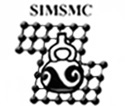
Module: Damascus and
Pattern-Welded Steels
Home
SIMSMC Philosophy
Description
Objectives and Design
Instructors
Program Structure
Modules
Evening Lectures
Field Trips
Schedule
June 2005 SIMSMC
Participants
Module 1
Module 2
June 2004 SIMSMC
Participants
Module 1
Module 2
June 2003 SIMSMC
Participants
Module 1
Module 2
June 2002 SIMSMC
Participants
Module 1
Module 2
Comments
Course Manuals
Travel & Housing
Who Should Apply?
NSF Support
How to contact us
Requirements for
Applicants
APPLY!
Module: Damascus and Pattern-Welded Steels
Coordinating instructor: Samuel M. AllenTheme:
"Damascus steel" is a type of steel of legendary hardness
and toughness that western European culture first encountered through
the Crusades. While its name relates to the area in which weapons and
armor were fashioned from this unique material, the source of the steel
and the technology for making it was India (where the technology was
practiced for well over 1000 years, up to about 1900). Damascus steel
became of intense interest in western Europe between the 17th and 19th
centuries, because of its legendary properties, its unique "damascene"
visual appearance, and the inability of European craftsmen to understand
or duplicate the process for its manufacture. The Europeans
had developed ways to make tools and armor with a similar appearance,
by forge-welding composites of iron and steel in the solid state to
form "pattern-welded steel." Pattern welding advanced to a
remarkable state of refinement in Europe in the 19th century. Only in
the last twenty years has the scientific understanding of Damascus steel
advanced to the point where it can be made reliably. Research on this
unique material continues to the present.
Module Program:
This module will explore the history of Damascus and pattern-welded steels
through study of publications and historical documents dating to the 17th
century. We will review a first-hand 19th century account of observations
of the Indian process for making the "Wootz" steel from which
Damascus steel was made. In addition, we will study the history of the
technology for making pattern-welded steels and contrast it with the Damascus
steel processing. Recent articles will be included showing that both types
of steels remain of strong interest today, both from an artistic/craft
standpoint and for the potential for applying facets of the historical
technology to make ultrahigh strength steels that might be superior to
modern commercial steels. Principles of ferrous metallurgy will be integrated
with the lecture material to give participants the necessary background
to appreciate technical aspects of the topic, and laboratory work will
include fabrication of pattern-welded steel by forge welding.
Material culture component:
Important issues that will be addressed include trade of Wootz from
India westward, assessment of the perception of Damascus steel as a
superior material by Europeans, understanding the reasons for intense
scientific interest in Damascus steel in France in the early 19th century,
and concluding with the qualities of Damascus and pattern-welded steels
that have endowed both with such enduring interest.
Materials science/engineering and laboratory component:
An appreciation for the historical and cultural aspects of Damascus
and pattern-welded steels requires integration of metallurgical understanding
of the materials and processes used in their manufacture and the techniques
for fabrication of useful objects from these materials. Lectures on
ferrous metallurgy will cover the necessary fundamental principles,
with specific emphasis on phase equilibria, solidification structures,
hot working, and relation of microstructure to strength and toughness.
Laboratory sessions will involve participants in using traditional hand
forging techniques to produce billets of pattern-welded steels, and
small articles such as letter openers will be fashioned from the material
we make. Metallographic examination of the materials we work with at
various stages of processing will help connect lecture material to practice.